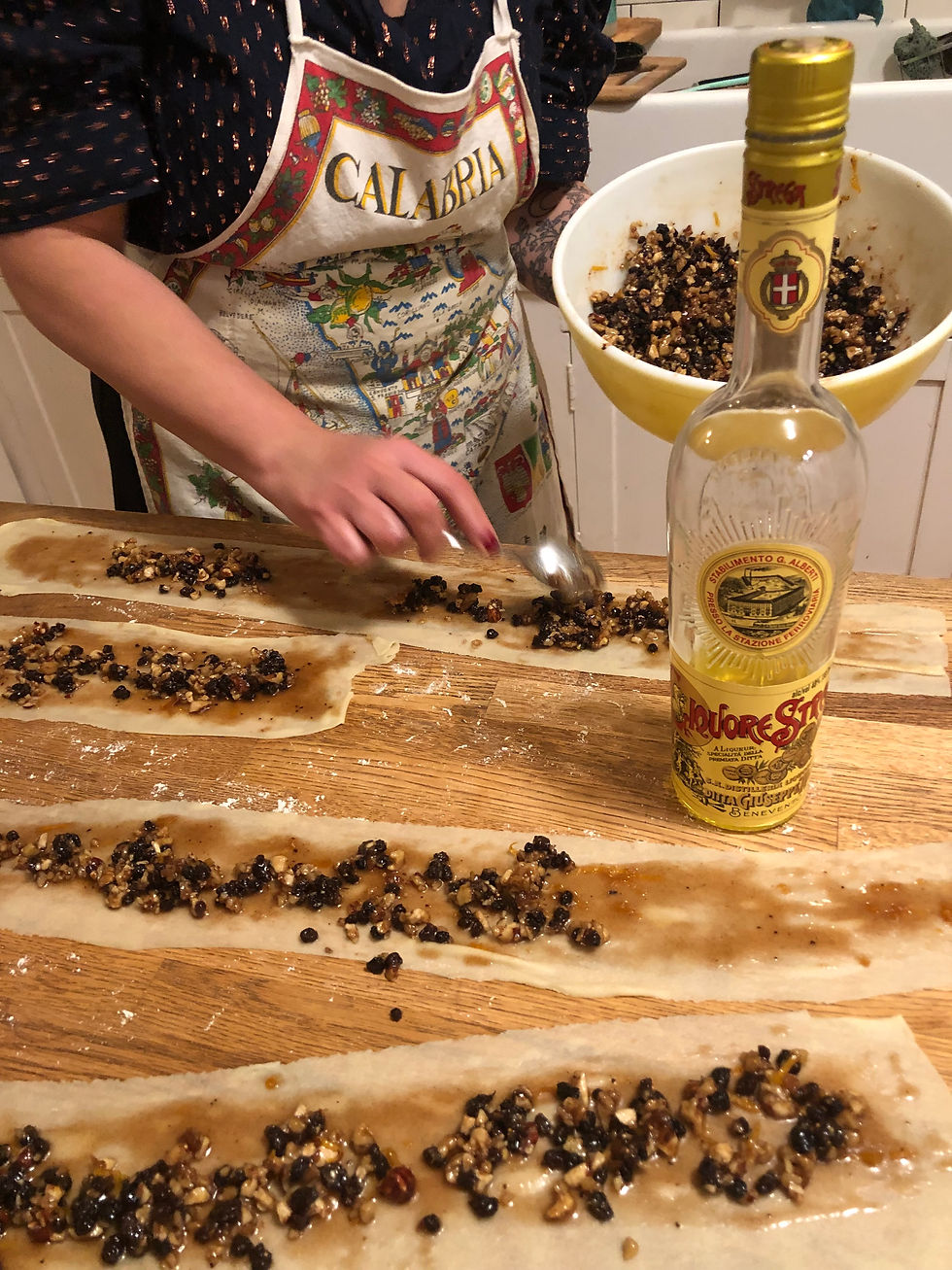Baking for the Crone
- kara wood

- Dec 27, 2022
- 6 min read
Winter, Capricorn season. the 12 days of Christmas, Epiphany-ITS CRONE SEASON!
We are in the last days of 2022
New Year’s Eve as we know it was an invention of the ancient Romans. In 153 B.C. they moved the start of the new year from the Spring equinox to January 1 and dedicated the first month of the year to Janus, the two-faced god of beginnings, who looks back toward the old year and ahead toward the new one. Since we celebrate the new calendar year in winter, during the time of death, not rebirth, the energy of the crone is our usher into the new year.
For me, the days between Dec 21, the Winter Solstice and Feb 2, Imbolc are reserved for my devotion to crone. The crone within and crone all around.
And, of course people have been doing this for as long as we have been doing anything: Winter is the earths embodiment of the crone.
Befana, Calliach, Baba Yaga are a few of the more well known of the Winter Crones (from Italy, Scotland and Slavic cultures, respectively).
They are the wise woman, the hag, the elder, the witch; at one time a dominant energy that all were in relationship with and now, vilified, shut away from the current dominant culture because of fear of death, fear of her power, fear of her truth; unapologetically in communication with death, with the energy of time, winter and magic. She does not fight what is inevitable, she becomes it.
I will be going deeper into this energy over the next month, stay tuned.
For now, I light my oven, my hearth for her and I bake for the crone.

This Christmas I made Pitta ‘nchiusa/raisin, nuts and honey pastry from Calabria (or Pitta ‘mpigliata o pittacupassule) is a typical Christmas pastry from Calabria, and it's Vegan!
It is usually enjoyed for Christmas but as we are still in the 12 days of Chrismas and especially in Italy Jan 6 (epiphany, three kings day, Befana's day) is celebrated, I want to share my version of this delicious special dessert.
The ingredients are all an offering to the crone: honey, nuts and Strega liquor are some of the magic ingredients.
My version inspired from
8-12 portions


The pastry The pastry can be made using a food processor, or a food mixer or by hand
125 g Italian 00 flour or all purpose flour (I used Italian 00) 125 g fine Italian durum wheat flour called semola rimacinata pinch of salt 60 ml extra virgin olive oil 60 ml white wine, white vermouth or sherry 60 ml warm water, adding more if necessary to obtain a supple dough 1 tablespoon honey
The filling:
200 g toasted assorted nuts (walnuts, almonds, hazelnuts), chopped coarsely approx. 1/8 of a teaspoon salt approx. ½ teaspoon - ¼ teaspoon ground cinnamon approx. ¼ teaspoon + 1/8 teaspoon ground cloves 200 g currents, sultanas or raisins
Several tablespoons fig jam (you can also add fresh figs, peeled and smooshed, or reydrated dry figs, mashed up) the juice of one orange and grated zest 2 tablespoons of Strega liqueur (or amaro) 1 tablespoon clear, mild, runny honey 2 tablespoon of vincotto OR pomegranate syrup
For assembling the pastry:
60ml extra virgin olive oil
¼ teaspoon ground cloves+ 1 teaspoon cinnamon+ pinch of salt
the grated of 1 orange (yes, this is correct – it is not a mistake: overall 2 oranges)
230 g mild honey
pastry: mix together the flour and salt. Mix the liquid ingredients together and add them slowly to the flour mix, (switching the processor ON and OFF with the pulse switch if you are using).
At this stage you just want to fully hydrate the flour: stop when the mix starts to resemble coarse breadcrumbs. Let the dough rest, covered, for 20 minutes.
The dough should be soft, supple, but not sticky. Transfer it onto a lightly floured working surface and knead gently for a couple of minutes. The dough should be malleable and easy to work with. If your filling is ready and you want to roll the dough by machine, you can proceed straight away, otherwise, if rolling by hand, the dough must rest for 30 minutes, at room temperature, wrapped in cling film.
Preheat the oven to 350F
(I used a spring form pan lined with parchment paper)
To roll the pastry: I used a pasta machine so it would be nice and thin. You don't have to do this, you can also roll it out.
If using a pasta machine, divide the dough into six equal pieces; work with one piece at a time, keeping the others covered. Starting from the widest setting o the pasta machine, start thinning the dough, the pastry must pass through the last notch. It will be fragile, but better (because thinner) when you eat it. You will get long, thin strips.
Place them horizontally on table/counter.
From the “assembling the pastry” list: mix the oil, the spices, the salt with three tablespoons of honey. Warm this up just to make it easier to spread it. Brush this mixture over the strips of dough. Divide the nut filling equally between the 6 strips and spread it out as much as possible. Cut each strip lengthwise so as to obtain two narrow and long strips. Loosely roll up each tube onto itself, starting from the short side : some of the filling will escape and that is fine – you will put it back in at the end. The top edge must stay open. Repeat with the other half.
Start assembling the pitta ‘nchiusa by placing the largest rosetta (little rose/coil) in the middle of the tin; place all the others around it. You might have to nudge them a little in order to fit all of them in the tin, but try hard not to seal the top when you handle them: you must be able to see the filling. Put back any filling that has escaped during shaping.
Mix four tablespoons of honey with two tablespoon of Strega liqueur (or Marsala/Brandy) and pour over the cake. bake in the middle of the oven for approximately one hour, checking after the initial 30 minutes. It must be golden brown.
Remove from the oven and pour the remaining honey all over (this part is optional).
Let it rest until warm and enjoy it. The pitta ‘chiusa keeps for up a week, at room temperature, loosely covered with foil.
YUM they are so good and rich and magic. ENJOY!
AND, one more recipe to share:
A favorite I have been making the past several Epifany eve is a cake for Befana, recipe below

La Befana Cake (this is my version altered from gathervictoria.com)
Above image from Jan 2020 Winter Italian Folk Medicine class, The last in person class I facilitated. I hope to return to in person soon!
Ingredients:
• 1 & 1/4 cup cornmeal or polenta
• 3/4 cup almond flour
• 3/4 cup brown sugar (little extra or sprinkling on top) or 1/2 cup of honey
• 1/3 cup softened butter
• 3 & 1/2 cups of milk
• 2 teaspoons lemon or orange zest
• 2 tablespoons currants or raisins
• 3 tablespoons candied orange and buddha hand peels (chopped)
• 2 tablespoons minced candied ginger
• 3 tablespoons dried apricots (finely chopped) or cranberries
• 1 cup diced fresh apple
• 1/4 cup of Amaro
• 1 & 1/2 teaspoon fennel seeds
• 1 & 1/2 teaspoon of anise seeds
• Teaspoon or so of sea salt
• 2 tablespoons of almond flakes for garnish, sprinkled powdered sugar
Directions:
• Put all the candied fruit, raisins, ginger, apricots in a bowl, pour over the Amaro and allow to soften for an hour.
• Bring the milk to a boil with a pinch of salt. Once you have reached the boil, pour in the almond flour and polenta, slowly, mixing well with a whisk, so that it does not form lumps. Reduce heat to low, continue to cook, stirring constantly, for about 10-12 minutes. The mixture should be soft and non-gritty so add more milk if necessary. It will be thick.
• Remove from heat, then add the butter in chunks, the diced apple, brown sugar, brandy-soaked dried fruit, fennel and anise seeds.
• Mix well, then pour the mixture into a pre-greased round springboard cake tin (8 -9 inch). Level it, sprinkle the surface generously with brown sugar. Cook at 350 F for about 50-55 minutes, a beautiful golden-brown crust should form on the surface. If you used honey you may need an additional 7-10 minutes but don’t overbake as it will firm up and set once cool. Let sit overnight so flavors can intermingle and deepen!
Below image of me cutting the Befana cake for our class in 2020 at Ancestral Apothecary in Oakland.

Image of Befana on class Altar
from
Happy Baking and Eating!
XO
Kara



Comments